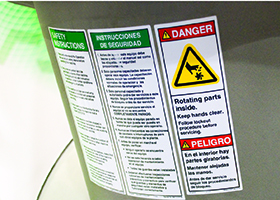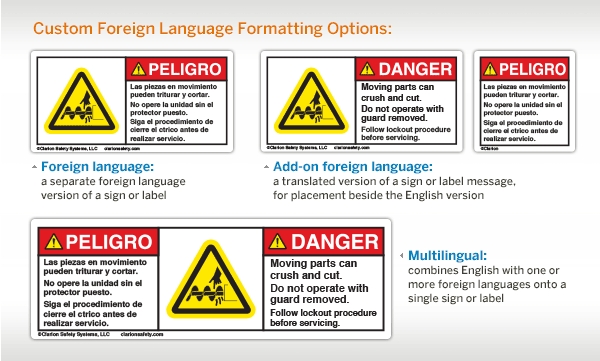Languages and Your Product Safety Labels
Posted by Clarion Safety Systems | 10th May 2017

When should your safety labels use additional languages? Languages are a reoccurring topic that we’ve seen as a struggle point for both our customers and the standards committees that we’re a part of.
Safety labels need to be quickly and easily understood so people can gain an immediate awareness of hazards and avoid accidents and injuries. With increasing diversity in workplaces, you have to take into consideration whether or not your audience reads English.
Currently there’s no obligation in the U.S. to provide warnings in multiple languages on products. Yet for product manufacturers, the goal is always to put a safe product into the marketplace. This often means providing adequate warnings when hazards can’t be designed out of the product. So, how do you ensure that your potentially lifesaving on-product warnings are effectively understood by your intended audience, which may contain people who can’t read English?
The ANSI Z535.4 product safety label standard has a large degree of flexibility built into the format options it gives manufacturers for their safety labels. In addition, in the standard’s Section 3.1.1 and Annex C, it allows manufacturers to use product safety label formats contained in the international product safety label standard, ISO 3864-2. When it comes to the issue of languages on safety labels, here’s what ANSI Z535.4 says in its Annex B, Section 5:
“If it is determined that additional languages are desired on a safety sign, the following formats should be considered. In all examples, the use of symbols is strongly encouraged in order to better communicate the sign’s hazard information across language barriers.”
This section of the standard goes on to illustrate multilingual safety label formats that combine English and foreign language text and signal word panels onto a single safety label, including vertical and horizontal options that can be modified to include multiple word message panels and multiple signal word panels. Other formatting options include standalone foreign language safety labels (that are, essentially, translated versions of the entire label), or “add-on” foreign language labels placed beside the English label.

How do you select the language or languages to use on your U.S. product safety labels? The phrasing in Annex B, Section 5 speaks to this: “ If it is determined that additional languages are desired…” ANSI Z535 does not make the determination as to what specific languages should be used. That decision belongs to you – the design engineer, the manufacturer, the facility owner. You’re in the better place to make the determination that your signs and labels may or may not need to use more than one language; you know whether or not your products’ expected audiences would benefit from additional languages.
For more insight on language and your product safety labels, be sure to read our recent article in In Compliance Magazine, part of a series on current trends in safety symbol design.
Here at Clarion, with our custom capabilities, we’re available as your resource to effectively communicate safety to your non-English reading audiences with accurately translated safety signs and labels. Contact us today!